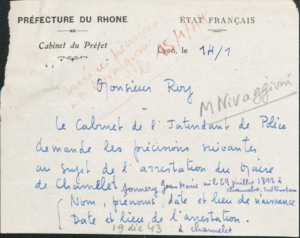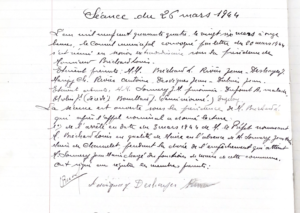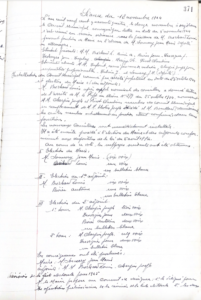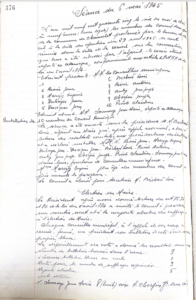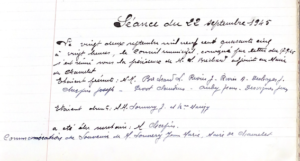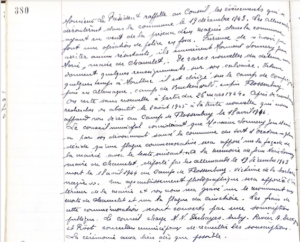
Chamelet has lost it’s Mayor.
Sebastian Jean-Marie Sonnery was arrested on 19th December 1943. While he remained Mayor of the Commune in name, no one had any up-to-date information as to where he was or when or if he would ever be back. Since his election, there had never been a Process-Verbal to elect an Adjoint, so there was no one to step up. The members of the Conseil Municipal were depleted. In addition to Monsieur Sonnery’s absence, Mayor Tholin had died less than a year before. Monsieur Marizy was unwell although still attending meetings, and M. Joannès BOUILLARD had been removed from the council for selling substandard wine in 1940.
So that left Jean RIVIER, Antoine RIVIER, Jean-Marie DESHAYES, Jean DESVIGNES, Louis BRÉCHARD, Jean-Marie DUBOIS, Joannés DUGELAY and André DUFOURT

On 5 January 1944, the Sous-Préfet of Villefranche Sur Saône wrote to the Préfet in Lyon about the situation in Chamelet. M. Sonnery was not the first Mayor to be arrested, and the Sous-Préfet wanted to know if anyone knew how long he would be detained.
In the event of there being no information at all, then a replacement was needed as the management of the commune was suffering.
The handwritten note in red instructs that the Office of the Commissaire of Police should be consulted.
Thursday, January 13, 1944
The Prefét sent a brief note to the Office of the Commissaire of Police on Tuesday, 12th January 1944. They required more details about M. Sonnery, and that task was handed to M. Roy, who delegated the task to a Monsieur Nivaggaum (?), who, according to the note in red, forwarded the information the following day.

11 a.m. on Sunday, 13 February 1944.
(50 Days since the arrest of Sonnery)
January passed, and no information was received regarding the fate of M. Sonnery; Note even his wife had been informed. She received no information until 27 February, when Jean-Marie was in Buchenwald, Germany.
The Conseil Municipal decided to meet and did so on 13 February.
It could have been regarded as an insubordinate act; who knows? Still, regardless, Jean RIVIER, Antoine RIVIER, Jean-Marie DESHAYE, Jean DESVIGNES, Louis BRÉCHARD, and Jean-Marie DUBOIS all attended, with Antoine RIVIER acting as secretary and Louis BRÉCHARD acting as president of the meeting in the absence of Jean-Marie SONNERY.
Friday 25th February 1944.
This is an unsigned handwritten note that states that according to the Préfet of Villefranche, the Maire of Chamelet had been deported to Germany. It is probably intended for the Prefet Delegue of Lyon as it states that Monsieur Limousin has suggested that Monsieur Bréchard take on the role.
A subsequent update clarifies that the subject is Louis Bréchard, a cultivator on the Conseil Municipal. He also offers that a precedent has been set from a similar situation in Saint Romain en Gier.
Louis Pingon was the mayor of Saint Romain en Gier, southwest of Lyon. He was arrested in April 1943 and died in Buchenwald in January 1944.
Monday 3 March 1944
Tuesday 4 March 1944
Despite sending the additional information the Police had requested, no response was forthcoming about the whereabouts of Mayor SONNERY. This letter, and ones like it, were commonplace for persons arrested in Vichy, France. The Préfet would report to the ambassador of France, and the ambassador would write back to the Préfet telling them to contact the Police.
The ambassador himself, M. BRINON, was one of the architects of French Collaboration and was executed by the Firing squad in 1947, having been found guilty by the French Court of Justice of war crimes.
The Prefét forwarded the letter to the Office of the Commisionaire of Police requesting, on behalf of the ambassador, information about M. Sonnery.
M. Sonnery was, at the time of this letter, in Flossenburg Concentration Camp.
Saturday 18th March 1944
The Sous Préfet notified the Préfet that it had received his ‘orders’ about who would be standing in for Mayor SONNERY during his absence and that they would be conveyed to the Conseil Municipal at Chamelet.
11:00 Sunday 26th March 1944
The Conseil Municipal met and undertook to follow the instructions of the Préfet Lyon that Louis BRÉCHARD would undertake the functions of Mayor of Chamelet during the absence of Monsieur. SONNERY
Friday 31st March 1944
After each Proces-Verbal of the Conseil Municipal (when an officer is confirmed) they are obliged to notify the Sous Préfet. On this day, the Sous Préfet at Villefranche sur Saone was notified that the Préfets instructions had been carried out.
Louis Bréchard was undertaking the role of the Mayor of Chamelet.
Monday 3rd April 1944.
(107 days since his arrest)
The Office of the Commissioner of Police responds to the request from The Ambassador of France asking the Préfet.
M. Sonnery was transferred to Compiénge on 6th January 1944.
This information was absolutely accurate, but to put it in some perspective. Firstly, it was 89 days out of date. His wife had by this time received two letters from her husband, the first saying he was en route to Buchenwald and the second telling her he was in Flossenburg. He had been in Flossenburg since 22nd February, and in just two weeks, Sebastien Jean-Marie Sonnery would be dead.
CUSSONAC signed the letter. Réne Cussonac was a Pétain loyalist who, since June 1943, was the Superintendent of the National Police Force, established by Vichy, responsible for Lyon. This pro-German Police Chief built a cadre of ‘trustworthy Frenchmen’, praised by Klaus BARBIE – the notorious Butcher of Lyon who said, ‘Without them, I could never have done my job so well.’
Cussonac enthusiastically hunted those who avoided the STO, members of the resistance and Jews. There are many horrific incidents with his fingerprints all over them.
After the liberation of Lyon, the Court of Justice was created on 29 September 1944. When the magistrates started work on 7 October 1944, Réne Cussonac was the first to be investigated.
The court sat for the first time on 3 November, and Cussonac was sentenced to death.
I am unsure when this entry was made in the état-civil in Chamelet. However, it shows that the record relied upon by the Minister for War Victims was the second one created by the 90th US Infantry Division rather than by the German death certificate, which showed the date of death as the day before – Monday, 17th April 1944.
It was also made retrospectively since this information was not communicated until, at the earliest, 1945 and, more likely, 1946.
Liberation
16:00 Sunday 12th November 1944
Lyon had been liberated on Sunday, 3rd September 1944, and the forces of Nazi Germany were in retreat.
A meeting of the Chamelet Conseil Municipal took place, the first time in relative peace and no longer under the rules of the VICHY Government. De Gaulle and his shadow government had returned to France from Algiers on Saturday, 9th September 1944.
The members of the Chamelet Conseil Municipal were still in the dark about the fate of Mayor Sonnery. However, they took the opportunity to carry out a process, no doubt enjoying the freedom to do so, that they had earned.
Monsieur Sonnery was elected Mayor of Chamelet, six votes to one for Louis Bréchard. Unbeknown to them, Chamelet had just elected a dead man.

Paris had been liberated on Saturday, 19 August 1944, and Lyon, 15 days later, on Sunday, 3 September. However, the war in Europe would not be over until the following year.
German Marshal Alfred Jodl signed the surrender of German armies in Reims at the HQ of the Allied Expeditionary Forces on 7 May 1945. There followed a second capitulation on 8 May 1945 with representatives of the USSR, Great Britain, France and the USA. On this occasion, it was Marshal Wilhelm Keitel who signed at 11:01 CET, effectively marking an end to the hostilities in the war in Europe.
Despite this, the newly installed interim government decided to hold their first elections. Holding an election was, in itself, a truly momentous event for a country that had been occupied since June 1940. However, it was also the first election where women could vote.
With a two-round majority system used in the communes, the dates set were 19 April and 13 May 1945. At 09:00, 6 May 1945, two days before the official German Surrender, Chamelet was preparing for the Process-Verbal to elect its new Mayor.
Several members of the Conseil Municipal from 1935 had been re-elected:
Jean RIVIER
Antoine RIVIER
Jean DESVIGNES
Jean-Marie DESHAYES
Louis BRÉCHARD
New members included:
Claudius PIVOT
Joseph CHERPIN
Jean Joseph AUBY
and the first female member of the Conseil Municipal Eugénie MARIZY (née GIRARD), the wife of Charles Arséne MARIZY.
The Tenth place on the Conseil Municipal was indicated by a blank space adjacent to position 1 in the
Registre des Deliberations, a vacant space awaiting the return of Sebastian Jean-Marie SONNERY.
Nine members of the Conseil Municipal were able to vote. Voting was held on a simple majority system, and anyone receiving five or more voices would be a majority.
First, the election for the Mayor:
Jean Marie SONNERY – 8 Votes
Joseph CHERPIN – 1 Vote
Once again, Chamelet had unwittingly handed the office of Mayor to a man who had died at the hands of the Nazi occupying forces over one year ago.
1 Year, 19 days, to be exact.
Next, the vote for the Premier Adjoint – first deputy.
Louis BRÉCHARD – 5 Votes
Jean DESVIGNES – 2 Votes
Joseph CHERPIN – 1 Vote
Claudius PIVOT – 1 Vote
Louis BRÉCHARD was declared the Premier Adjoint.
Finally, the vote for the Second Adjoint.
Jean DESVIGNES stood unopposed and received nine votes.
20:00 Saturday, 22 September 1945
It wasn’t until 20:00 Saturday, 22 September 1945, that the Conseil Municipal, and by extension, the community of Chamelet, learned of the fate of their Mayor, Sebastian Jean Marie SONNERY.
The president of the Conseil Municipal explained the timeline from his arrest for refusing to denounce the Maquis up to his death in Flossenburg.
They went on to discuss and agree on a series of memorials to Mayor Sonnery. One is a plaque outside the Town Hall:
” In memory of Jean-Marie SONNERY, Mayor of Chamelet, deported by the Germans on 19 December 1943, died the 18 April 1944 in Flossenburg Camp. A victim of the Nazi barbarism.”
Sources
RESOURCES:
Registre des Deliberations, Conseil Muncipal de Chamelet Mars 1912 –
Archives du département du Rhône et de la métropole de Lyon 3353 W2 Chamelet 1944
SONNERY Sébastien (dit JEAN-MARIE) 3335W25, 3335W6 Archives du département du Rhône et de la métropole de Lyon
La cour de justice de Lyon, section du Rhone (septembre 1944-juillet 1949) Virginie Sansico. Histoire de la Justice 2008 Pages 45 à 57
Archives du département du Rhône et de la métropole de Lyon cour de justice no 1277.
Chamelet État-Civil 1930 – 1949
ACKNOWLEDGEMENTS:
With thanks, Charles Bréchard, the grandson of Charles Marizy and Antoine LAFAY, for providing background and context for this page.
NOTES:
This page does not cover the general details of the Maquis’ movements. The politics, operations, locations and activities of the resistance within the Vallée d’Azurgues will soon be covered on other pages of this site. Only where specific actions are relevant to the objectives of this page will the detail, as far as it is known, be described.
This post is also available in:
 Français
Français

